NOTICE:
The description in this page is FICTITIOU.S.... and might contain English mistakes.
Contents
"True Story" of Gungriffon
Although I do not know whether this is commonly known, it is a fact that the story line Gungriffon English version has is totally, compeletely, absolutely different from that of the original Japanese version.
Now, I'd like to introduce why actually the Third Wolrd War began, who actually fought, and what role they played, deriving from the descriptions in-game and in the related books, magazines and websites. Please enjoy the fictitious history class!
[Special thanks to GameA, the author of the article "GUN GRIFFOWND," who correctly pointed out the differences between the Japanese and English versions. This article motivated me to make this page.]
World After Year 2000
2002
- MDM, McDonnell Douglas Mitsubishi, the joint venture of McDonnell Douglas and Mitsubishi Heavy Industries (三菱重工業), was established. Financial difficulty had MD seek a new market in Asian region and take in strong Japanese Yen.
2003
- The EU expanded into the PEU, Pan European Union, by containing Northern and Eastern Europe, Russia, and CIS.
2004
- Caterpillar succeeded in developing practicable 2-legged machinery.
2005
- The Monroe Doctrine, an isolation policy conducted in 19c, again came into force. The United States decided to live independently within the Americas and started protecting trade. The creation of the U.S.-led AFTA, American Freedom Trade Association [It's not a good English I think, but officially set :p], caused the world to lose a vast market and substitute with others, that is, the Middle East and Africa. Also, the U.S. pulled out its military forces from all over the world, which disabled the United Nations' activities and forced Japan to find another key stone to its defense.
2006
- 2-legged machinery came to be seen in many workplaces.
- The U.S. Army started earnestly studying legged machinery.
- United Defense Industries demonstrated its experimental 2-legged gun-platform vehicle.
- The OAU, Organization of African Unity, expanded and covered whole African continent.
2007
- The U.S. Army set up the "AWGS Program," a development program of legged AFV. AWGS stood for "Armored Walking Gun System."
- It was the all-terrain mobility that the U.S. Army emphasized in the program rather than firepower and armor. The army required the new vehicle to be capable of moving on uneven, rubbled surfaces, on close alleys, and in the woods where ordinary vehicles cannot travel.
2008
- The PEU Force was formed, which was actually just for form.
Apr/
- The JGSDF, Japan Ground Self-Defense Force (陸上自衛隊), set up the "SH Program (SH計画)"; SH stood for "Sôkô Hokô 装甲・歩行," meaning "Armored and Walking." This program obviously resembled the AWGS Program of the U.S. Army.
Jun/
- Now China had become a great power in terms of both economy and military. The other Asian countries had initially banded together to deal with its influence, before they came to plan avoiding a direct confrontation with it; East Asian countries and some Oceanian countries established the APC, Asia-Pacific Community, and set China as its leader, which allowed China to have political dominance in the region.
Jun/
- The AWGS Program of the U.S. Army started its trial.
3, Aug/
- The Second Sino-Vietnamese War began. Vietnam asked the UN for the intervene, while China vetoed.
9, Sep/
- China, irritated by the bogged down war, managed to have sanction resolutions against Vietnam passed among the APC.
- The APC Force was formed and immediately sent to Vietnam. Japan financially contributed to the APC Force but refused to send the JSDF, excusing that its Constitusion did not allow the participation in war, which provoked a strong criticism from the other APC countries.
Nov/
- The PEU Force set up the program for uniforming the equipment and organizations.
2009
- The JGSDF started improving the Type90 MBT (90式戦車) into the Type90+ (90式戦車改). (image on the left) [It is the friendly sand-colored tanks appearing in GG opening movie.]
- The German MBT Leopard 3 rolled out. (image on the right) [And it is the enemy green tanks in the movie.]
Feb/
- Singapore mediated China and Vietnam. The APC Force retreated from Vietnam, virtually meaning its defeat.
Apr/
- The foreign minister of China, Wang Ming (王明) visited Japan to unofficialy request the rivision of the Constitusion.
- The JGSDF's SH Program started its trial.
Jul/
- In the AWGS Program, the U.S. Army selected both the M16 2-leg Walking Combat Vehicle developed by United Defense and Vickers as a bipedal category vehicle (image), and the M15 "Land Crab" by General Dynamics as a multi-legged category.
- At first, the adoption of the M16 was intended to replace the M3A3 Bradley Cavalry Fighting Vehicles belonging to mechanized infantry divisions, and the M15 was to replace the M12 LOSAT Anti-Tank Vehicles [the Bradley vehicle with the MGM-166 LOSAT]. Later, the U.S. Marines received marinized versions of them both to replace the AAVP-7s and AAVP-8s.
Aug/
- The U.S. Army set up the "Advanced AWGS Program."
22, Sep/
- Jane's Defence Weekly Magazine published an article titled "What Can Be the King of Battlefield?" This article strongly suggested the concept of something later called HIGH-MACS.
-
The article pointed out that though an AWGS' all-terrain capability is attractive, its weight limit (25t for 2-legged type, 40t for multi-legged) due to the form of locomotion, walking on foot, fatally has an AWGS softer than an MBT;
that an MBT is capable of having heavy armor, high firepower and powerful engine, which could make it the king;
and that an attack helicopter is now a natural enemy of an MBT, but there extist problems of an attack helicopter:
- High visibility
- Weak armor
- Low survivability
- Close operational range
- Low acquisition rate
- Inability under enemy's air mastery
- Disability to dominate battlefield
- High mobility
- Sufficient armor
- Capability to dominate battlefield
- Long operational time
- Capability to cope with enemy aircrafts
- All-weather capability
Oct/
- China officially requested Japan to revise the Constitution at the talks in Beijing.
Dec/
- MDM, McDonnell Douglas Mitsubishi, started making a conceptual design of the HIGH-MACS, High-Mobility Armored Combat System.
- This study found that a "flying" AWGS would be the answer.
2010
Jan/
- In the SH Program, the JGSDF selected both the Type9 Armored Walking Combat Vehicle (9式装甲歩行戦闘車) (image on the right) developed by Cadillac Gage and Komatsu (小松製作所), and the Type10 Armored Walking Combat Vehicle (10式装甲歩行戦闘車), Japanese licensed production of the German AWGS Tiger Walking Combat Vehicle. [The quadruped Type10 only appears in GG Blaze.]
Jun/
- An APC summit was held in Tokyo, mainly about the Japanese Constitution.
Aug/
- MDM launched the "HIGH-MACS Project."
- Later, bringing with the HIGH-MACS, MDM participated in the Advanced AWGS Program of the U.S. Army together with McDonnell Douglas, and in the New SH Program of the JGSDF.
Oct/
- Japan revised its Constitution after some political turbulences.
- According to the revision, the JPN.F.L., Japan Foreign Legion (日本外人部隊), was organized to partake in the APC Force. ["JPN.F.L." is not a good English abbreviation, either, I guess...it should be simply "JFL," shouldn't it?]
2011
- Krauss-Maffei and General Motors started manufacturing the AWGS Tiger Walking Combat Vehicle.
- Renault started manufacturing the AWGS Autruche. (image)
- The U.S. Army started deploying the M16 2-leg Walking Combat Vehicle.
- The JGSDF set up the "New SH Program" (新SH計画).
- The program required a new, 2nd generation AWGS to have following qualities: capability to run faster than 80km/h on road, better firepower than Type9, and armor capable of protecting from 35mm MG in front and 20mm MG in the other parts.
Apr
- Since MDM's HIGH-MACS distinctively excelled in the New SH Program, the HIGH-MACS Project was taken into an official project by the Japan Defense Agency (防衛庁).
2012
- Porsche and Krupp-MaK started manufacturing the AWGS Panther Walking Combat Vehicle. (image)
- The U.K. Royal Air Force started deploying the AWGS Valiant Support Combat Vehicle developed by Alvis.
- The Italian Army started deploying the AWGS Littorio developed by Fiat and OTO Breda.
- The Russian Army started deploying the AWGS BMX (image) and IMR-XG. [IMR never appears in-game.]
16, Jun/
- The first HIGH-MACS prototype rolled out in the Zama Laboratory (座間研究所), Kanagawa Prefecture, Japan. A walking test for it was initially started, since an engine, newly developed by General Electric to provide capability of flight, was not finished in time.
Aug/
- The new GE engine for the HIGH-MACS, named "White Hole," was finished.
- A flight test was implemented in the U.S. for the second HIGH-MACS prototype equipped with the engines.
3, Sep/
- An operational test for the HIGH-MACS prototype was implemented in Hokkaido, Japan.
17, Oct/
- Final tests for the HIGH-MACS were started in the Zama Laboratory.
12, Nov/
- The HIGH-MACS was officialy adopted as the Type12 Armored Walking Combat Vehicle (12式装甲歩行戦闘車). Also, it was decided that the Type12s were to be primarily deployed to the JPN.F.L. [This is the machine players operate in GG1.]
2013
- The worst harvest years in the Americas began from this year.
- Armscor started manufacturing the AWGS Elephant. (image)
Jun/
- The U.S. Army purchased the HIGH-MACS as the VW-1, whose capital letters respectively stood for "VTOL" and "Walk." This happened a few months after Japan's purchase because the U.S. (AFTA) did not and would not face a critical situation very soon, unlike Japan (APC) having worse relationship with the PEU countries. The VW-1s were received by the combat aviation brigades of armor divisions and mechanized divisions, and by the 82nd Airborne Division and 101st Airborne Division to replace the attack helicopters.
Sep/
- The PEU Force purchased the AWGS Panther and Tiger in the uniform program.
2014
- The PLA Ground Force of China started deploying the AWGS Type13 Armored Walking Vehicle and Type14 Armored Walking Vehicle both developed by Norinco. (images) Each was basically a dead copy of the BMX and Littorio.
- The JPN.F.L. 1st Air Mobility Division (第1空中機動師団) was established in Higashi-Chitose, Hokkaido (北海道千歳市東千歳), which had the largest JGSDF station.
18, Mar/
- The JPN.F.L. 501st Mobile Anti-Tank Combat Squadron (501st MACS, 第501機動対戦車中隊), the "Gungriffon," was established in Higashi-Chitose, replacing the anti-tank helicopter units equipped with AH-1Ss. [This is the company the players first belong to in the series.]
Aug/
- A conflict began between Tchad and Tunis.
Oct/
- Libya, militarily supported by the PEU, intervened the conflict, and then won.
- Libya started intending to become a leader in the Islamic region, which required to compete against Egypt with considerable military force.
24, Oct/
- The HIGH-MACS II, the Type12+ Armored Walking Combat Vehicle (12式装甲歩行戦闘車改), rolled out and was placed to the JPN.F.L. 501st MACS for practical tests. (image) [This is the machine players mainly operate in GG2.]
Nov/
- The PEU Force sent as many as 40,000 soldiers to Libya to be stationed. Egypt expressed strong protest against the Libyan military expansion and, at the same time, enhanced its military power as a pressure, supported by China.
- Contrary to Egypt's expectation that the pressure would prevent the situation from getting worse, the PEU-Libyan combined forces started repeatedly drilling near the boundary with Egypt. Egypt regarded that the conflict would be inevitable, so requested the APC to station in hope of the effect of military presence. The APC Force immediately responded by sending 4 divisions from the Lanzhou Military Region 21st Group Army, which brought about the PEU-Libya temporarily retreating.
Beginning of the Third World War
2015
- The Jagdpanther Walking Combat Vehicle, so-called "German HIGH-MACS," developed by Porsche and Krupp-MaK, was completed in this year [possibly between March and May].
Jan/
- The PEU German Army 12th Mechanized Infantry Division arrived at Libya to further enforce, before the APC JPN.F.L. 101st Armored Division arrived at Bilbeis, Egypt. The tension between these two countries became extremely high level.
late Jan/
- The PEU-Libya backed in the drill near the boundary.
1, Feb/
- The JPN.F.L. 501st MACS arrived at Bilbeis.
8, Feb/
- Near Benghzi, Libya, the PEU-Libyan combined forces started moving under the complete radio silence, which caused the APC Command to recognize the situation not as just a drill, but as an invasion against Egypt. With insufficient military force, the Command decided to make a preemptive attack and invade Libya in order to retard the enemy's invasion.
- The C-17 transporters of the APC Force were ordered out and took off with 16 HIGH-MACSs of the JPN.F.L. 501st MACS.
9, Feb/
- The APC-Egyptian combined forces, including the JPN.F.L. 101st Armored Division, started advancing beyond the border from Sallum, Egypt to Tobruk, Libya.
- HIGH-MACSs of the 501st airborned 30km behind the PEU-Libyan forces, and succeeded in a sneak attack against them, without the APC declaring war.
- After the APC's surprise attack, the PEU declared war.
- In the afternoon, the 501st made the second sortie in the same day. [GG2 Mission1]
- The APC-Egyptian forces occupied Sarrir oilfield and marshalled troops, which soon later found a mistake.
- The JPN.F.L. 504th Mobile Anti-Tank Combat Squadron (504th MACS, 第504機動対戦車中隊), later nicknamed the "Phantom," was established in Higashi-Chitose.
10, Feb/
- The cruise missiles from Russia, the airborned AWGS Panthers of the PEU German Army 26th Airborne Brigade (Luftlandebrigade 26), and the PEU Air Force from Europe fired back to the close-set APC-Egyptian forces. The PLA troops were heavily damaged. As a result, the APC-Egypt started retreating from Libya, though only a day after the outbreak.
12, Feb/
- The APC JPN.F.L. 101st Division and the 501st MACS implemented a rescue operation at a desalination plant in Sidi Barrani. [GG2 Mission2]
14, Feb/
- The PEU German Army 5th Mechanized Infantry Division forayed along the coastline and annihilated the APC-Egyptian troops in the Halfaya Pass; the retreating APC-Egypt forces were run across the dessert to the Qattara Depression. [GG2 Mission3]
- The APC and the PEU started negotiating a ceasefire, in Geneva.
- Later, the negotiation resulted in two agreements: Prohibition on naval combat; and prohibition on attack against non-military targets. Hence, the (later called) Third World War basically had a form of what you call a limited war.
16, Feb/
- The PEU Army "Afrika Korps," the German Army 3rd Corps in North Africa, raided the APC-Egypt at the Suez Canal.
- Later, the Afrika Korps Command regarded that it would be impossible to swiftly end the war, and blocked the Canal with the torpedoed civil ships.
22, Feb/
- 22:00, the Egyptian Government declared through CNN that it would brake off the coalition with the APC and implement a ceasefire in 24:00. However, China bought over a bellicose group in the Egyptian Army and had them declare the establishment of the junta, even by 23:00.
23, Feb/
- The PLA troops tried to occupy the congress hall in Cairo in response to the request by the junta, while the Egyptian guardian troops fired back. The APC troops and the PEU troops also took part in the battle of Cairo, with the Geneva agreements forgotten. Finally, China regarded its plan as a failure and took a scorched earth operation, from which heavy damage on civilians resulted.
- On the other hand, Russia began trying to absorb Ukraine, intending to solve its extremely serious food crisis. Russia had been having 5-year harvest failure which made a lot of people starve, though its neighbor Ukraine had relatively rich crop. The conflict between the countries both belonging to the PEU put the Afrika Korps into confusion.
24, Feb/
- The cruise missiles flying from an unidentified place (some information implied that they were from Ukraine) destroyed the Afrika Korps Command. The order was lost and each PEU troop started retreating desparately by themselves.
- The PLA troops defeated the Egyptian Government troops, successfully having the junta keep the coalition between the APC and Egypt.
28, Feb/
- By this date, every unit of the PEU Afrika Korps either withdrew from Africa or surrendered. The APC and the PEU agreed to a ceasefire.
Eurasian Conflict
2015
early Mar/
- The JPN.F.L. 501st MACS was placed to the 1st Air Mobility Division.
26, Mar/
- Invaded by Russia, Ukraine requested the APC for assistance. The APC formed rapid deployment forces and sent to the Kharkov battlefront. [GG1 Mission1]
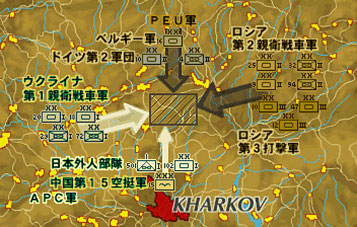
View Larger Map- North
- PEU Belgian Army/ 6th Armored Division
- PEU German Army 2nd Corps/ 10th Armored Division, and 4th Mechanized Infantry Division
- East
- PEU Russian Ground Forces 2nd Guards Tank Army/ 25th and 9th Tank Divisions, and 32nd and 94th Guards Motor Rifle Divisions
3rd Shock Army/ 10th, 47th, and 12th Guards Tank Divisions
- PEU Russian Ground Forces 2nd Guards Tank Army/ 25th and 9th Tank Divisions, and 32nd and 94th Guards Motor Rifle Divisions
- South
- APC JPN.F.L./ 1st Air Mobility Division 501st MACS, and 102nd Armored Division
- APC PLA Air Force/ 15th Airborne Corps
- West
- Ukrainian Ground Forces 1st Guards Tank Army/ 20th and 18th Guards Tank Divisions, and 29th and 72nd Guards Mechanized Divisions
- North
10, Apr/
- To break a deadlock in the north Kharakov battlefront, the PEU decided to take a full-scale intervention. The PEU combined forces, consisting of the German, French and Polish troops, advanced to Kiev. Although defeated in the battle near the boreder with Poland, the Ukrainian Army struggled to defend the capital city. The APC, regarding Kiev falling as Ukraine disrupting, sent troops to Kiev. [GG1 Mission2]
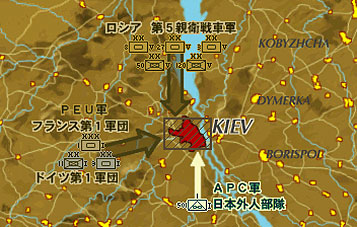
View Larger Map- North
- PEU Russian Ground Forces 5th Guards Tank Army/ 8th Guards Tank Division, 27th Tank Division, 3rd Guards Tank Division, 50th Guards Motor Rifle Division, and 120th Guards Motor Rifle Division
- West
- PEU French Army 1st Corps
- PEU German Army 1st Corps/ 11th Mechanized Infantry Division, and 3rd Armored Division
- South
- APC JPN.F.L./ 1st Air Mobility Division 501st MACS
- North
12, Apr/
- Kiev fell, soon before it shocked Russia that the republics located east of the Ural Mountains declared independence as the Siberian Community, due to Russian opressive exploitation. China again led the situation, but Kazakhstan, which has a key point of the Trans-Siberian Railway, was not talked into betraying the PEU, which could prevent the plan from total success.
- Russia urgently sent the troops supposed to be deployed to Sevastopol, which temporarily had Ukrinian gorvernment functions, to Novosibirsk. The U.K. and Italy, which originally had been against the war, decided to send troops because of their reliance on food, energy and rare metal supplied from Siberia.
- China, also highly dependent its resource supply on Siberia, supported the Siberia full force. In addition, since an Asian region was involved this time (unlike the battle of Kharkov), some APC countries, including even Thailand and Australia, sent troops to assist the battlefront. Japan had the worn-out 1st Air Mobile Division and 102nd Armored Division retreat from the now stable battlefronts in Ukraine, and sent them to the Novosibirsk battlefront after supply and reorganization.
20, Apr/
- In the west of Novosibirsk, the JPN.F.L. 501st MACS and 502nd MACS tried to ambush the Trans-Siberian Railway transporting the PEU forces;
the PEU did trap too, so the ambushing JPN.F.L. troops were actually ambushed. In the end, the experienced 501st barely avoided a defeat, but the newbie 502nd was annihilated. [GG1 Mission3]
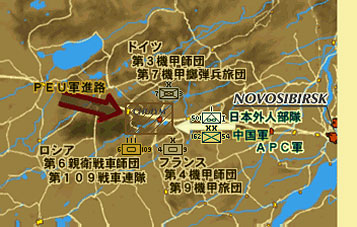
View Larger Map- North
- PEU German Army 3rd Corps/ 7th Mechanized Infantry Brigade
- South
- PEU Russian Ground Forces/ 6th Guards Tank Division 109th Tank Regiment
- PEU French Army/ 4th Armored Division 9th Armored Brigade
- East
- APC JPN.F.L./ 1st Air Mobility Division 501st MACS
- APC PLA Ground Force/ 54th Group Army 162nd Motor Rifle Division
- North
- After this, Novosibirsk fell, owing to successful smooth transportation by the PEU.
7, May/
- A cargo airplane carrying an APC's VIP crashed in Vostochnaha Litsa (Восточная Лица), Kola Peninsula. The APC sent troops, including the reorganized JPN.F.L. 502nd MACS, to make an SAR (search and rescue) operation, and the PEU also to capture the VIP. [GG2 Mission4]
- At this point, HIGH-MACS II was placed to the 502nd MACS.
15, May/
- The APC-Siberian combined forces succeeded in retreating to Mongolia. Both the APC and the PEU concentrated their power to the great plain near Ulaanbaatar. [GG1 Mission4]
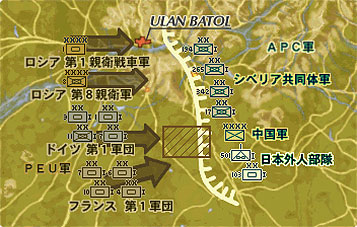
View Larger Map- West
- PEU Russian Ground Forces 1st Guards Tank Army, and 8th Guards Mechanized Corps
- PEU German Army 1st Corps/ 3rd, 1st, and 7th Armored Division, and 11th Mechanized Infantry Division
- PEU French Army 1st Corps/ 7th, 6th, 10th, and 4th Armored Division
- East
- Siberian Community/ 194th, 265th, 342nd, and 17th Motor Rifle Divisions
- APC PLA Ground Force/ Group Armies (Shenyang, Beijing, Jinan)
- APC JPN.F.L./ 1st Air Mobility Division 501st MACS, and 103rd Armored Division
- West
16, May/
- The battle of Ulaanbaatar ended up a PEU Russian victory tactically, but it could be said that it ended up a Mongolian one strategically; Mongolia, supposed to be an APC member and be defeated, suddenly agreed to ally with the PEU and successfully got independent from China. The true loser was the Siberian Community, which failed to achieve independent from Russia.
- Tibet was inspired to get independent and rose in revolt against China. The PEU German Army sent airborne troops to Lhasa in order to break a stalemate in the Beijing battlefront; the APC also sent the 503rd MACS under the newly formed JPN.F.L. 2nd Air Mobility Division (第2空中機動師団).
- Moreover, Vietnam, which thought by watching the Tibet rebellion that China had got weak, again started invading China.
24, May/
- The JPN.F.L. 503rd MACS successfully suppressed the Tibet rebellion and kept Tibet in the APC, before it was sent to Guangzhou (广州) to stop the Vietnamese Army advancing northward.
- The battle in Datong (大同) began. Not only goes through the Great Wall in Datong, but also the final defense line of Beijing was drawn. Therefore, China pressured the APC countries to dispatch troops.
30, May/
- The JPN.F.L. 501st MACS, suffering from lack of fuel and unable to fly, was annihilated in the battle of Datong. [GG1 Mission5]

3, Jun/
- The JPN.F.L. 502nd MACS was sent to Jartai (吉兰泰) to recapture a nuclear warhead left in an ICBM base. [GG2 Mission5]
11, Jun/
- Tibet declared independence from China.
28, Jun/
- Vietnam invaded China. The JPN.F.L. 503rd MACS aided the PLA defensing in Nanning (南宁).
14, Jul/
- A coup d'etat occured in Beijing. The southern part of China, which had already enjoyed economic growth and recently had been invaded by Vietnam, no longer wanted to continue the war. In contrast, the northern part yet on the way to grow thought it vital to continue and win. Japan, which had been hesitating to involve the war since the breakout, decided to support the Chinese rebel group trying to stop the war, but ordered out only one unit, the JPN.F.L. 103rd Armored Division, to partake, in case the coup failed.
- Eventually, the coup turned out much unlikely to achieve; then the Japanese Government ordered the JPN.F.L. 503rd MACS to suppress the rebellion, to attack its "ex-"friend, the 103rd.
23, Jul/
- Seeing China's disorder, Australia declared defection from the APC.
- After this, other APC members such as Thailand and Singapore followed and departed from the APC.
30, Jul/
- Chinese and Japanese forces, including the JPN.F.L. 504th MACS, were sent to Darwin to penalize Australia.
- The 504th occupied an airport in Darwin, but did not make advancement anymore because of low morale and empathy for Australia.
3, Aug/
- The JPN.F.L. 504th MACS in Australia started retreating.
6, Aug/
- The JPN.F.L. 504th MACS was reorganized and sent to China. At this point, HIGH-MACS II was placed to the 504th.
Re-emergent World Police
2015
7, Aug/
- The U.S. declared war against the APC, simultaneously giving a surprise attack to APC bases. The APC -- at this time, virtually meaning only China and Japan -- Navy and Air Force got heavily damaged, which allowed anyone to feel free to land China anytime. Japan, which had learned in the past that an enemy landing makes it impossible to defend, advised China to surrender, but only to find to be ignored.
13, Aug/
- The U.S. Government declared that it would exercise deadly sanction against China. The AFTA combined forces, mainly consisting of the U.S. MEF(Marine Expeditionary Force)s, landed Lianyungang (连云港) and beated the APC Force. [GG1 Mission6]

14, Aug/
- On the course of assistance for the JPN.F.L. 103rd Division to retreat to Taian (泰安), the 504th MACS battled against the AFTA in Zaozhuang (枣庄).
17, Aug/
- The JPN.F.L. 504th MACS tried to make a "reverse-occupation" operation of an occupied air base, a bridgehead of the AFTA, in Tancheng (郯城). The operation somewhat contributed to reducing the AFTA forces, while the 504th also had largely damaged. [GG2 Mission6]
- The U.K. declared defection from the PEU and allied with the AFTA.
mid-late Aug/
- The AFTA forces advanced to the (ex-)APC countries and occupied them almost without facing resistance.
- The report by CNN that the AFTA was willing to invade Europe from France made the PEU forces in China confused. A Chinese general Zhang LinBao (張林雹) successfully took advantage of this to assault and repel the PEU, so that the PLA got ready to cope with an AFTA invasion.
- The conflict between Egypt and Libya recurred.
2, Sep/
- The AFTA forces started landing Normandy despite the expectation that the AFTA would proceed an invasion of Europe after defeating the APC. Northern Europe (Lapland and Denmark) and Benelux countries declared defection from the PEU as well as neutrality.
- The JPN.F.L. 502nd MACS was annihilated when defending Beijing.
3, Sep/
- With sufficiently supplied, the AFTA forces in China started advancing to Beijing.
9, Sep/
- The JPN.F.L. 504th MACS assisted the APC forces retreating across the Yellow River nearby Jinan (济南). [GG2 Mission7]
11, Sep/
- The AFTA forces in France started rapidly advancing to Paris, a few days before France surrendered.
12, Sep/
- The JPN.F.L. 504th MACS assisted the surrounded 103rd Armored Division retreating in Weifang (潍坊), but the 103rd finally surrendered because of the U.S. 82nd Airborne Division's strong enforcement. This made the 504th lose its purpose to continue combat, and hence surrender. [GG1 Mission7]
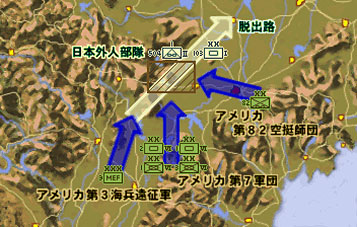
- Also, the PLA troops escaping northward were eventually destroyed.
16, Sep/
- The AFTA forces now occupied the two-thirds of the Chinese territory. The APC accepted unconditional surrender.
22, Sep/
- The German Army was defeated in the battle of the Rhein. Germany surrendered.
25, Sep/
- In Bailingmiao (百灵庙), China, the U.S. Army implemented operational tests for various AWGSs, including the duel of Michael Hartmann, a German ace pilot operating a customized Jagdpanther Walking Combat Vehicle (image), and Shin Nakano (シン・中野), a Japanese ace pilot operating a HIGH-MACS II. [GG2 Mission8] [Supposedly, those pilots' names are respectively derived from Erich Hartmann and Michael Wittmann, and from Shin Kazama of "Area 88"]
9, Oct/
- The AFTA forces occupied Moscow.
10, Oct/
- A radical group of the Russian Forces took control of an ICBM base in the Ural Mountains and launched a nuclear missile to Moscow. They threatened the AFTA to continue nuclear attack against all over the wolrd unless the AFTA forces retreat.
12, Oct/
- To regain control of the ICBM base, a selected HIGH-MACS team was dispatched and struggled with automatic-operationed enemies. [GG1 Mission8]
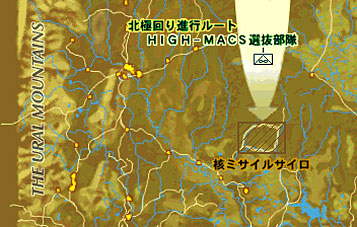
- North
- Selected HIGH-MACS Team
- North
- After the team successfully regained, the U.S. Government declared the end of war.
- The Russian Forces accepted unconditional surrender.
in-game description
| JP | JP | EN | |
|---|---|---|---|
| 1 | 北アフリカで始まったAPCとPEU の戦いは、新たな戦局を迎えた。 食料危機解決のためロシアが、穀倉地 帯のウクライナ再併合に踏み切ったのだ った。 ウクライナを援助するためAPCは、 中国・日本の緊急展開部隊をハリコフに 送った。 北アフリカ戦線に投入されていた日本 外人部隊第501機動対戦車中隊は、兵 力の補充後、第1空中機動師団に編入さ れ、新設された第102機甲師団と共に ハリコフに投入された。 |
The war between the APC and the PEU, which started in Northern Africa, has entered a new phase as Russia initiates further steps to re-absorb Ukraine in hopes of solving its increasing food crisis. The APC has sent emergency forces from China and Japan to Kharkov to aid Ukraine. Dispatched in the Northern Africa battlefront, the Japan Foreign Legion 501st Mobile Anti-Tank Combat Squadron incorporated into the 1st Air Mobility Division after supplied and the newly formed 102nd Armored Division were sent to Kharkov. |
The war between the PEU and the APC, which started in Northern Africa, has escalated as China and Japan initiate further steps to capture the Ukraine in hopes of solving their increasing food crisis. The PEU and UAC have sent emergency forces from the U.S. and Europe to Kharkov to aid the Ukraine. Stationed in Slovakia and Hungary, the Ameciran Foreign Legion 45th armored division and the newly formed 97th Squadron were incorporated into the First Airborne Division sent to Kharkov. |
| 開戦から2ヶ月、ウクライナ北部戦線 の膠着を打開するためポーランドから侵 攻を始めたPEUは、電撃的進撃を続け ウクライナの首都キエフに迫った。 また、北からは白ロシアの第5親衛戦 車軍がキエフに迫っていた。 キエフ陥落はウクライナの崩壊である ことを理解するAPCは、ハリコフ戦線 から部隊を割き、キエフ防衛に投入 することを決定した。 |
Two months after the war broke out, the APC invaded Poland and made their way to Kiev, the capital of the Ukraine. Their purpose was to bring an end to the deadlock at the Ukrainian northern front. The 103rd tank division of the APC closed in on Kiev. Knowing that the fall of Kiev means the end of the Ukraine, the UAC decided to send a division of their forces battling at Kharkov to defend Kiev. |
||